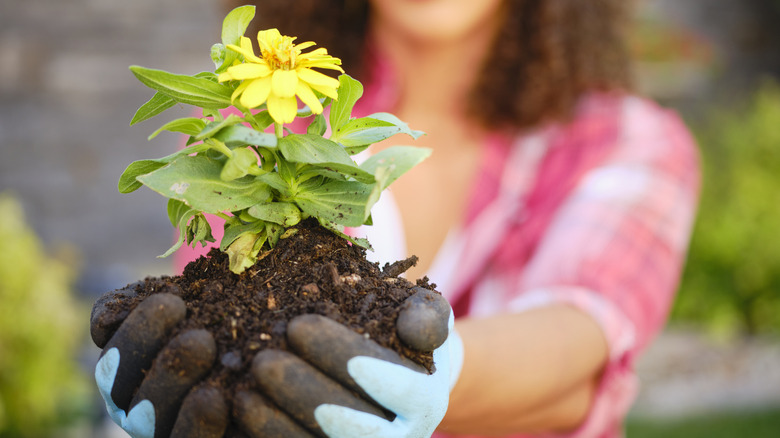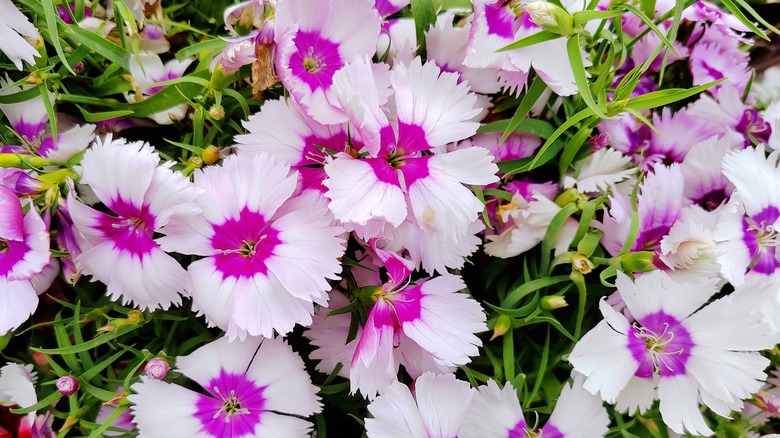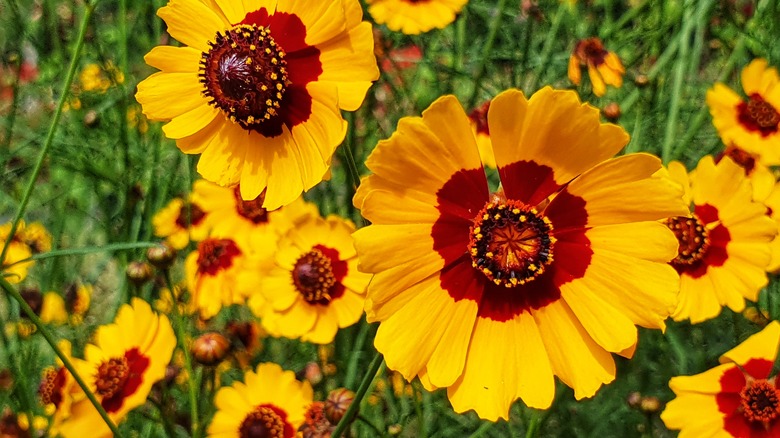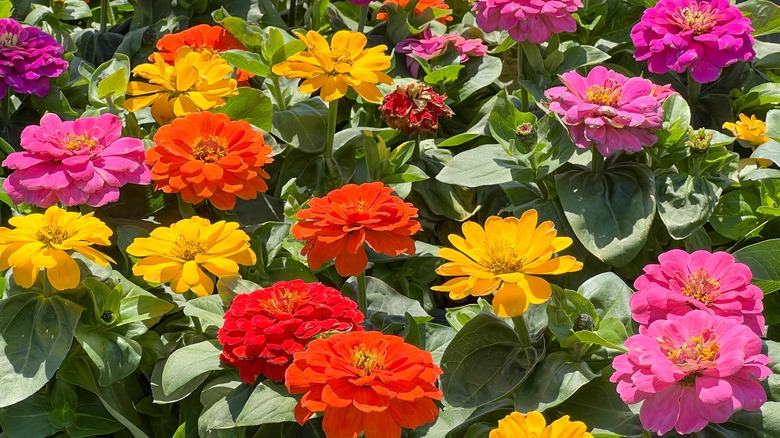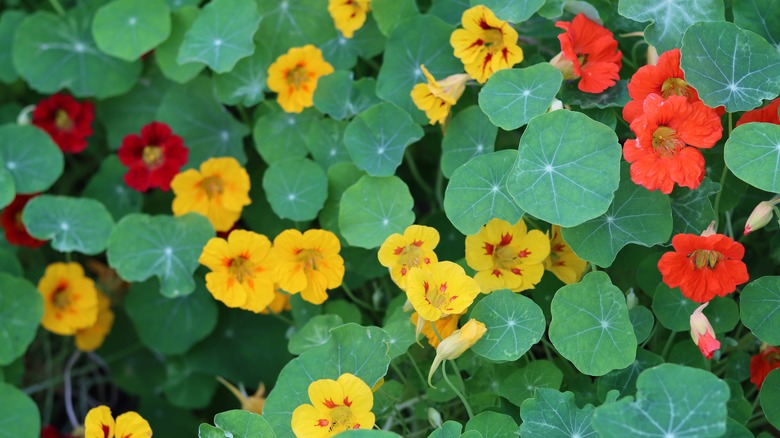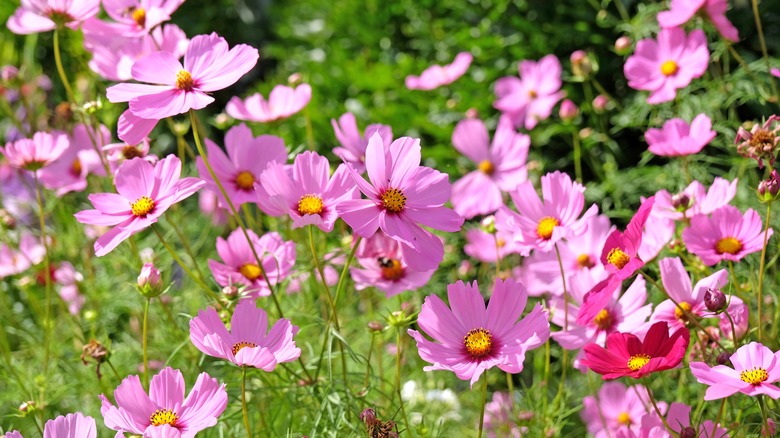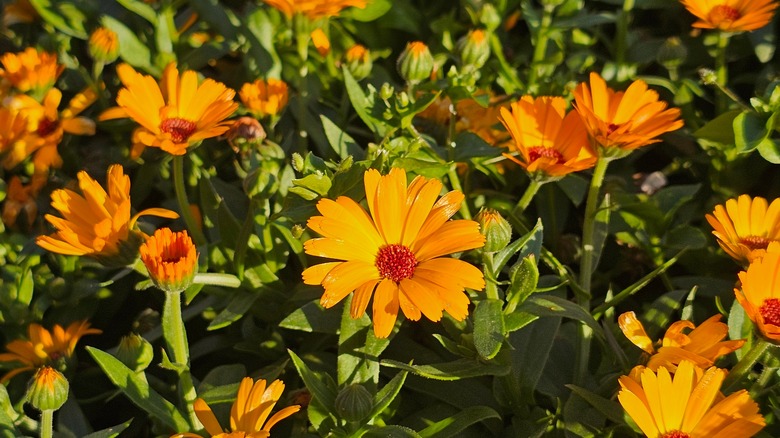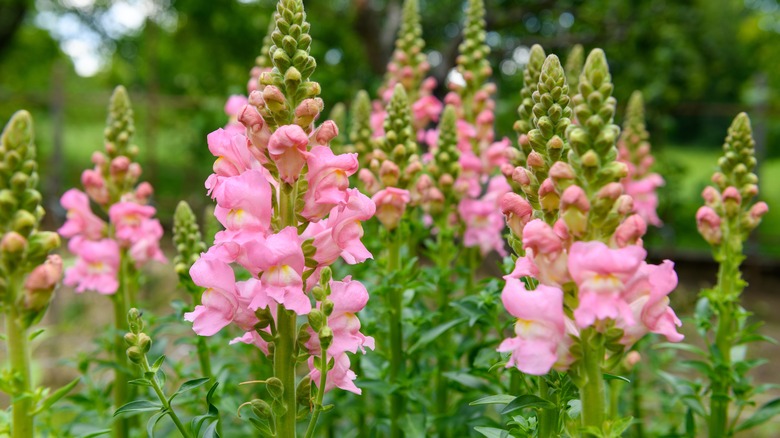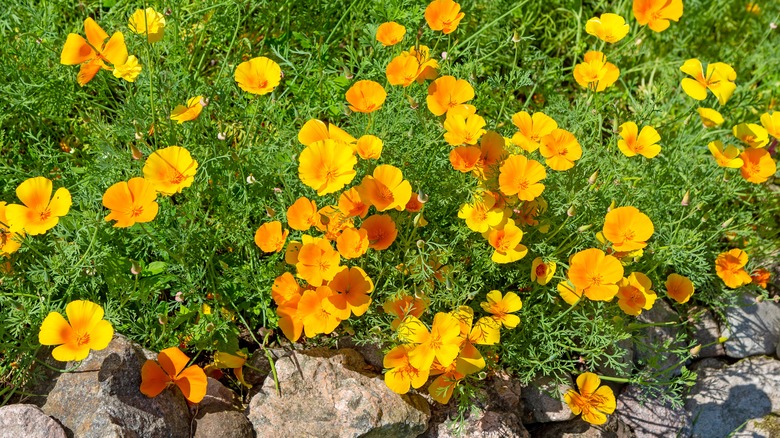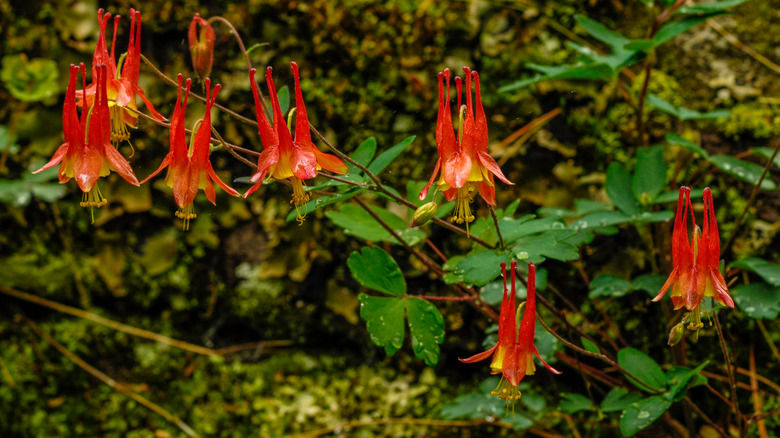12 Of The Easiest Flowers To Grow For Beginner Gardeners
The leap from buying flats of already-blooming impatiens from your local garden center to sowing seeds of your own can seem impossibly far. It's hard to commit to an uncertain outcome — what if, after all your planning and planting, nothing comes up? Luckily, there are a number of flowers that typically deliver a good return-on-investment with minimal knowledge and effort from the gardner. Garden icons like snapdragons, sunflowers, and zinnias appear among these selections, accompanied by some possibly under-appreciated stunners like nasturtium and columbine.
Growing plants from seed has a number of advantages, not the least of which is cost-effectiveness, seeing as seeds are generally inexpensive (or, in some cases, free). You'll also be able to access a variety of specialty seeds through catalogs that you might not find pre-grown at that plant store near you. Some seeds are best sown directly in your garden, while others might be more successful if you start them indoors and then transplant them outside once they're mature enough.
Purple coneflower
Purple coneflower (Echinacea purpurea) is one of those prolific flowers that will actually seed itself if left to its own devices. Plant seeds of these stately purple plants from the daisy family indoors 20 to 28 days before moving them outdoors, or you can sow them directly outdoors in the fall. Just cover them lightly in soil and try to provide them with cool, moist growing conditions. A U.S. native found in central and eastern states, purple coneflower is suited to USDA Hardiness Zones 3 through 8 and can be grown in full sun or partial shade.
Sunflowers
Iconic, cheery sunflowers (Helianthus spp.) are fast growers despite their size, and growing them is easy. Just plant the seeds 1 to 2 inches deep in the soil and 6 to 12 inches apart once the threat of frost has passed. To give them a strong start early in life, make sure to water the young plants regularly – but when they're more established, they're quite drought and heat tolerant. Sunflowers are hardy in zones 6 through 9 and should be planted in a sunny spot, preferably in a site that provides a bit of shelter from strong winds.
Pinks
Fragrant and vibrant pinks (Dianthus spp.) are not actually named for their color, although they are often pink — they're named for the fringed edges of their petals, which have the appearance of fabric cut with pinking shears. A large genus of full-sun-loving flowers, some notable and commonly grown species include China pinks (D. chinensis) and sweet William (D. barbatus), as well as the carnations (D. caryophyllus) often found in bouquets. You can easily sow pinks directly outdoors. Select a well-draining site and only cover the seeds lightly with soil. Generally, pinks are appropriate for zones 4 through 9.
Tickseed
It's easy to care for tickseed, also known as coreopsis. This U.S. native — Florida's state flower — delivers an especially long bloom time, from early summer until the first frosts. Most varieties are herbaceous perennials that spread via rhizomes, but annuals are also available. Plant perennials in fall, spring, or summer if well watered, while annuals can be sown directly in any well-draining soil after threat of frost has passed. Tickseed is extremely low-maintenance once established, tolerant of heat, drought, and humidity. Even with annual varieties, they tend to self-seed, so you can enjoy them next year, too.
Zinnias
For a flower that delivers a riot of color with minimal know-how and effort look no further than zinnias. These showy bedding annuals can be directly seeded in your garden as soon as the soil warms in spring and are tolerant of many soil types, as long as they get full sun. It's best to water regularly, but they can handle heat and drought — they originally hail from hot, dry regions of Mexico. Zinnias can be grown in zones 3 through 10 and are resistant to the attentions of deer and rabbits, while still attracting pollinators.
Nasturtium
Beautiful, edible, easy to grow, and ideal as a companion plant or trap crop to draw pest insects away from vegetables — nasturtiums (Tropaeolum majus for trailing and climbing types, T. minus for bushy types) might be the total package. For best results, find a nice sunny spot for these annuals in zones 2 through 11 and sow the seeds after the last frosts in late spring or early summer. Water regularly, but don't overwater — and don't bother with fertilizer, as nasturtiums prefer poor soil. Too many nutrients can actually reduce the amount of blooms you'll be able to enjoy.
Cosmos
Few flowers are more visually charming than easy, breezy cosmos. These annuals produce tall flowers that reseed themselves quickly and generously fill space, so you'll get quite a lot of bang for your buck. Even better, they're extremely simple to grow from seed — just scatter, rake loosely into the soil, and keep them moist and you'll start to see blooms within seven weeks that will continue until the first frosts. There's no fertilization necessary, either. The best blooms come from low-quality soil. Cosmos are suited to zones 2 through 11 and prefer at least partial sun.
Calendula
Although it's also known as "pot marigold," calendula (Calendula officinalis) is actually a member of the daisy family. It can be grown as an annual from zone 2 and a perennial above zone 8. The blooms and stems are edible and look lovely as cut flowers; plus, the more blooms you take, the more calendula might produce. Calendula is easy to directly sow in your garden: Just plant the seeds ¼ to ½ of an inch deep. Light will keep them from germinating. And use fresh seeds every year for annuals. Choose a sunny spot and water the young plants regularly.
Snapdragons
You may have childhood memories of squeezing snapdragon (Antirrhinum majus) blooms to make them pop open like little mouths. These charming flowers are quite easy to grow from seed. You can sow them directly in your garden, but maybe try starting some seeds indoors to transplant. Just sprinkle or press the seeds on top of the soil in a tray without burying them, as they need light to germinate. Cover the tray with plastic wrap or a lid to maintain humidity, and wait eight to 10 weeks before transplanting them outdoors. Snapdragons are hardy in zones 7 through 10.
California poppies
A common sight along roadsides or hiking trails in California, where it's the official state flower, the lovely California poppy (Eschscholzia californica) is easy to grow from seeds scattered in a sunny area. And once you've managed to grow a few California poppies, chances are, you'll have more. They're enthusiastic self-seeders (but not invasive!). They'll happily grow in poor soil, but do require good drainage. Sow them in fall, and once they've started blooming, deadhead regularly to encourage further blooms. California poppies are hardy in zones 6 through 10 and may behave as short-lived perennials above zone 8.
Cornflowers
Whether you know them as cornflowers or bachelor's buttons, Centaurea cyanus brings a unique pop of blue to a cool-weather garden. Just find a nice sunny spot (maybe with a bit of shade, if you live in a hotter climate), then plant the seeds about 2 inches apart and a ¼-inch deep in weeded, raked soil. In zones 2 through 11, you can plant cornflowers in the coldest part of spring before the frosts have even retreated; those above zones 7 can actually plant them in fall of the prior year, and may see even bigger and taller flowers.
Columbine
To attract hummingbirds to your garden, any number of columbine (Aquilegia spp.) varieties would be a great first foray into growing your own flowers. Generally comfortable in zones 3 through 8, columbine prefers partial shade but can also tolerate full sun as long as the soil is moist. You can sow columbine outdoors after the last frost or start it indoors eight to 10 weeks prior — just press the seeds into the soil without covering them. If you let some of the final blooms of the year go to seed, you may see new seedlings popping up next year.
